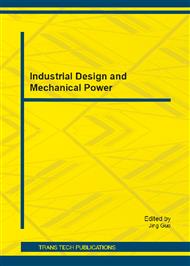[1]
X. Du, A. Sudjianto and W. Chen, An integrated framework for optimization under uncertainty using inverse reliability strategy, ASME Journal of Mechanical Design 126(4) (2004) 562-570.
DOI: 10.1115/1.1759358
Google Scholar
[2]
Z. P. Mourelatos and J. Liang, A methodology for trading-off performance and robustness under uncertainty, ASME Journal of Mechanical Design 128(4) (2006) 856-863.
DOI: 10.1115/1.2202883
Google Scholar
[3]
B. D Youn, K. K. Choi and K. Yi, Performance moment integration (PMI) method for quality assessment in reliability-based robust optimization, Mechanics Based Design of Structures and Machines 33(2) (2005) 185-213.
DOI: 10.1081/sme-200067066
Google Scholar
[4]
J. Tu and K.K. Choi, A new study on reliability-based design optimization, ASME Journal of Mechanical Design 121(4) (1999) 557-564.
DOI: 10.1115/1.2829499
Google Scholar
[5]
M. Hohenbichler and Rackwitz, Improvement of second-order reliability estimates by importance sampling, ASCE Journal of Engineering Mechanics 114(12) (1988) 195-2199.
DOI: 10.1061/(asce)0733-9399(1988)114:12(2195)
Google Scholar
[6]
C. Y. Lin, W. H. Huang, M.C. Jeng and J.L. Doong, Study of an assembly tolerance allocation model based on Monte Carlo simulation, Journal of Materials Processing Technology 70(1-3) (1997) 9-16.
DOI: 10.1016/s0924-0136(97)00034-4
Google Scholar
[7]
S.S. Isukapalli, A. Roy and P.G. Georgopoulos, Stochastic response surface methods (SRSMs) for uncertainty propagation: application to environmental and biological systems, Risk Analysis 18(3) (1998) 351-363.
DOI: 10.1111/j.1539-6924.1998.tb01301.x
Google Scholar
[8]
S.S. Isukapalli, Uncertainty analysis of transport-transformation models, Ph. D dissertation, The State University of New Jersey (1999).
Google Scholar
[9]
S.S. Isukapalli, A. Roy and P.G. Georgopoulos, Efficient sensitivity/uncertainty analysis using the combined stochastic Response surface method and automated differentiation: application to environmental and biological systems, Risk Analysis 20(5) (2000).
DOI: 10.1111/0272-4332.205054
Google Scholar
[10]
X. Xiong, W. Chen, Y. Xiong and S. Yang, Weighted stochastic response surface method considering sample weights, Journal of Structural Multidisciplinary Optimization, 423(6) (2011) 837-849.
DOI: 10.1007/s00158-011-0621-3
Google Scholar
[11]
S. Rahman and D. Wei, A univariate approximation at most probable point for higher-order reliability analysis, International Journal of Solids and Structures 43(9) (2006) 2820-2839.
DOI: 10.1016/j.ijsolstr.2005.05.053
Google Scholar
[12]
F. Xiong, S. Greene, Y. Xiong, W. Chen and S. Yang, A new sparse grid based method for uncertainty propagation, Journal of Structural and Multidisciplinary Optimization 41(3) (2010) 335-349.
DOI: 10.1007/s00158-009-0441-x
Google Scholar
[13]
I. Enevoldsen, M. Faber and J. Sorensen, Adaptive response surface technique in reliability estimation, Structural Safety & Reliability - Proceedings of the 6th International Conference on Structural Safety and Reliability, ICOSSAR'93 (1993).
DOI: 10.1016/0167-4730(93)90024-u
Google Scholar
[14]
H. P. Gavin, and C. Y. Siu, High-order limit state functions in the response surface method for structural reliability analysis, Structural Safety 30(2) (2006) 162-179.
DOI: 10.1016/j.strusafe.2006.10.003
Google Scholar
[15]
L. Olivi, Response Surface Methodology in Risk Analysis Synthesis and Analysis Methods for Safety and Reliability Studies, Plenum Publishing Corporation, New York (1980).
DOI: 10.1007/978-1-4613-3036-3_16
Google Scholar
[16]
M. Rajashekhar and B. Ellingwood, A new look at the response surface approach for reliability analysis, Structural Safety 12(3) (1993) 205-220.
DOI: 10.1016/0167-4730(93)90003-j
Google Scholar
[17]
I. Kaymaza and C. McMahon, A response surface method based on weighted regression for structural reliability analysis, Probabilistic Engineering Mechanics 20(1) (2005) 11-17.
DOI: 10.1016/j.probengmech.2004.05.005
Google Scholar
[18]
X. Nguyen, A. Sellier, F. Duprat and G. Pons, Adaptive response surface method based on a double weighted regression technique, Probabilistic Engineering Mechanics 24(2) (2009)135-143.
DOI: 10.1016/j.probengmech.2008.04.001
Google Scholar
[19]
C.M. Creveling, Tolerance Design: A Handbook for Developing Optimal Specifications, Addison-Wesley, MA (1997).
Google Scholar
[20]
S. Kim and S. Na, Response surface method using vector projected sampling points, Structural Safety 19(1) (1997) 3-1.
DOI: 10.1016/s0167-4730(96)00037-9
Google Scholar


